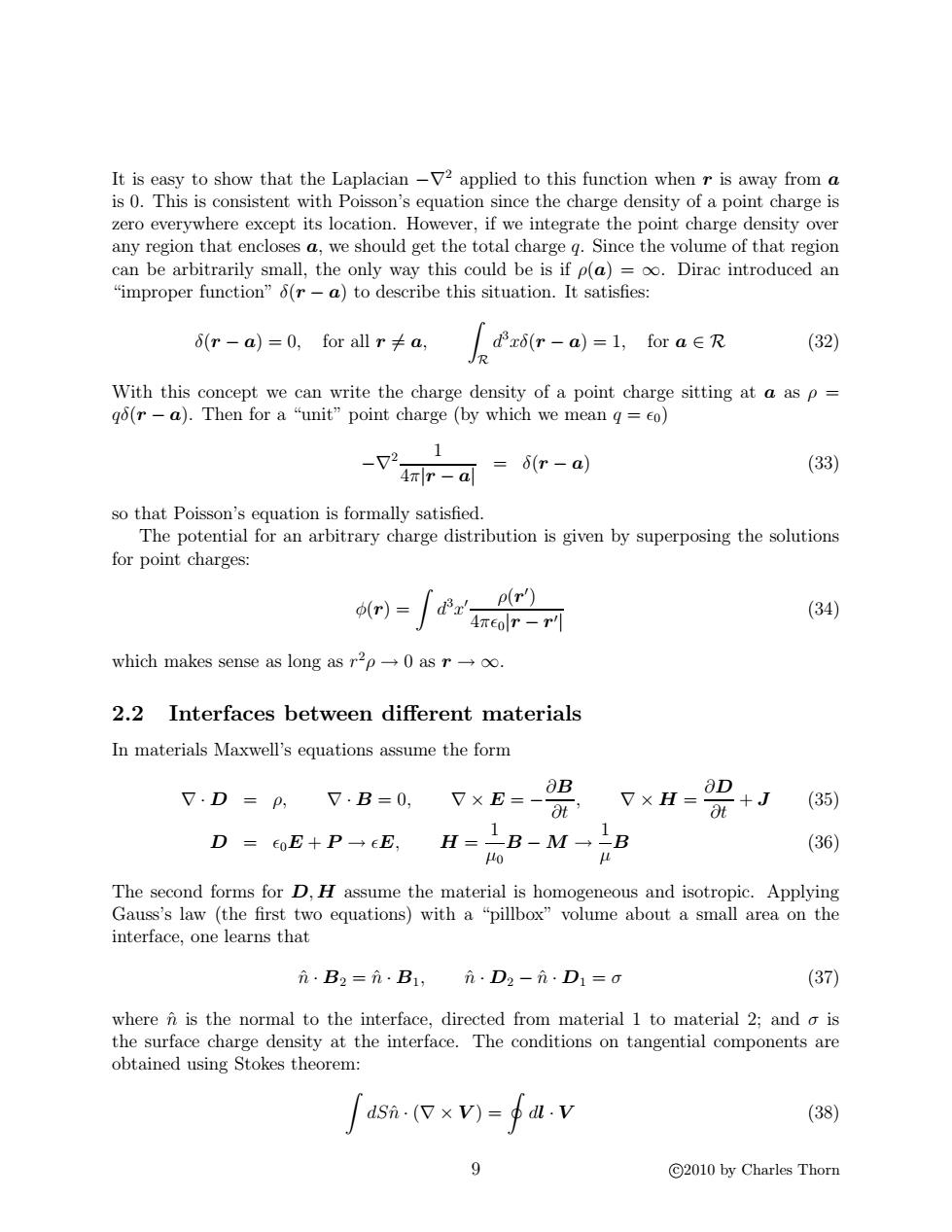正在加载图片...

It is easy to show that the Laplacian -V2 applied to this function when r is away from a is 0.This is consistent with Poisson's equation since the charge density of a point charge is zero everywhere except its location.However,if we integrate the point charge density over any region that encloses a,we should get the total charge g.Since the volume of that region can be arbitrarily small,the only way this could be is if p(a)=oo.Dirac introduced an "improper function"(r-a)to describe this situation.It satisfies: 6(r-a)=0,for all r≠a, dxd(r-a)=l,fora∈R (32) With this concept we can write the charge density of a point charge sitting at a as p go(r-a).Then for a "unit"point charge (by which we mean g=eo) -72、1 =(r-a) (33) 4πr-a so that Poisson's equation is formally satisfied. The potential for an arbitrary charge distribution is given by superposing the solutions for point charges: (r)= dx'、pr) 4πolr-r' (34) which makes sense as long as r2p→0asr→o. 2.2 Interfaces between different materials In materials Maxwell's equations assume the form ∂B 7.D=p, 7·B=0, 7xE=- Ot' V×H= D +J (35) D=0E+P→eE, H=1B-M→B (36) 0 L The second forms for D,II assume the material is homogeneous and isotropic.Applying Gauss's law (the first two equations)with a "pillbox"volume about a small area on the interface,one learns that n.B2=iB1,n·D2-i·D1=0 (37) where n is the normal to the interface,directed from material 1 to material 2;and o is the surface charge density at the interface.The conditions on tangential components are obtained using Stokes theorem: asa.(vxv)=pa.v (38) 9 ©2010 by Charles ThornIt is easy to show that the Laplacian −∇2 applied to this function when r is away from a is 0. This is consistent with Poisson’s equation since the charge density of a point charge is zero everywhere except its location. However, if we integrate the point charge density over any region that encloses a, we should get the total charge q. Since the volume of that region can be arbitrarily small, the only way this could be is if ρ(a) = ∞. Dirac introduced an “improper function” δ(r − a) to describe this situation. It satisfies: δ(r − a) = 0, for all r 6= a, Z R d 3 xδ(r − a) = 1, for a ∈ R (32) With this concept we can write the charge density of a point charge sitting at a as ρ = qδ(r − a). Then for a “unit” point charge (by which we mean q = 0) −∇2 1 4π|r − a| = δ(r − a) (33) so that Poisson’s equation is formally satisfied. The potential for an arbitrary charge distribution is given by superposing the solutions for point charges: φ(r) = Z d 3x 0 ρ(r 0 ) 4π0|r − r 0 | (34) which makes sense as long as r 2ρ → 0 as r → ∞. 2.2 Interfaces between different materials In materials Maxwell’s equations assume the form ∇ · D = ρ, ∇ · B = 0, ∇ × E = − ∂B ∂t , ∇ × H = ∂D ∂t + J (35) D = 0E + P → E, H = 1 µ0 B − M → 1 µ B (36) The second forms for D, H assume the material is homogeneous and isotropic. Applying Gauss’s law (the first two equations) with a “pillbox” volume about a small area on the interface, one learns that nˆ · B2 = nˆ · B1, nˆ · D2 − nˆ · D1 = σ (37) where nˆ is the normal to the interface, directed from material 1 to material 2; and σ is the surface charge density at the interface. The conditions on tangential components are obtained using Stokes theorem: Z dSnˆ · (∇ × V ) = I dl · V (38) 9 c 2010 by Charles Thorn